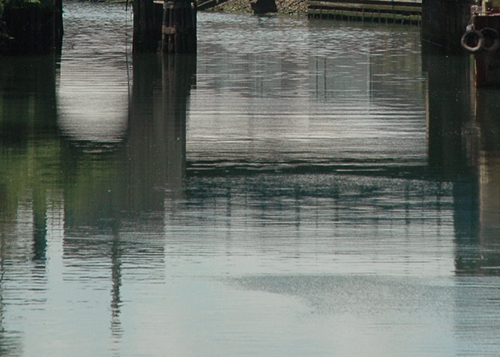Student Take Number One: "The Gowanus Problem"

We've written a bit about water quality issues associated with the Gowanus Canal, especially the last few days as some light has been shined under the rock of the Atlantic Yards Draft Environmental Impact Statement. As it turns out, the DEIS is (pardon us for saying this) full of shit when it comes to the impact Atlantic Yards will have on the Gowanus. The development, it seems, could set Gowanus cleanup efforts back by years, if not decades.
All this got us to reading more background about the Gowanus and its water. One of the more things we found was a paper entitled "The Gowanus Problem" written by a CUNY student. It offers some good background on how the Gowanus got to be in such bad shape.
In the late nineteen century the Gowanus canal was a significant waterway for New York City's commerce. Several industries lined its banks including heavy chemical, coal and gas manufacturing plants, oil refineries as well as a paint plant. By the turn of the century the government recognized the activities of the canal had caused it to become extremely polluted. In an effort to remove the pollutants, the city built a "Flushing Tunnel" in 1911 but unfortunately it shut down due to mechanical failure in the 1960's. As the canal returned to its former polluted and stagnant state, it also became a source of discomfort and concern for the residents in the surrounding community. The main concern was the potential health risk the canal posed to its immediate environment. In the thirty-seven years following the tunnel shutdown the waterway was continuously abused without any form of release. As the water became more polluted it lost most of its beneficial uses as well.Next, a high school student's comments.
The commercial use of the waterway was by far one of the main sources of pollutions. Shipping contributed to the vast amount of submerged and floating debris. The use of the canal by heavy chemical industries and the presence of both a metal and paint plant were detrimental factors that caused oil and grease floatables, pathogenic agents, toxicity to aquatic life and color, odor and turbidity problems. Wastewater disposal, which included the overflow of sewage treatment plants runoff due to heavy rains, emptied directly into the Gowanus. This was a main source of suspended material that contributed to the destruction of benthic communities and oxygen depletion. Fortunately, the opening of The Red Hook Pollution control Plant in 1987 reduced sewage flow into the canal. Garbage disposal including residents illegally dumping waste was aesthetically objectionable and may also have helped to destroy the benthic communities.
In the good old days, the canal was known for having an extremely large shellfish population and while these creatures were not a harmful factor, they did however require a low level of pathogenic microorganisms, suitable substrate and adequate food to survive. When these features were lost the shellfish died. Swimming also wasn’t a damaging factor but it too required low levels of pathogenic agents and aesthetic acceptability. Wildlife (birds, waterfowl) survival depended on an exclusive use of the canal as well as adequate food, while the survival of fish required adequate food and dissolved oxygen.
As the water quality became more undesirable, interest began to increase as people became aware of the water’s state. It became apparent that the aesthetic quality was becoming increasingly low. Wildlife was seen less, and since aesthetically unappealing conditions now existed, it was certain that problems associated with other beneficial uses of the water also existed. The fact that the water released a pungent aroma (as the result of decomposing sewage sludge) indicated that, dissolved oxygen was reduced so that a healthy biotic system was absent. The recreational potential of the water was basically eliminated as it became grossly polluted. Activities such as swimming were not even a consideration. To do so one would literally be risking death. This fact was confirmed in 1972 when tests discovered that there was live hepatitis, typhoid and a virulent strain of cholera in the canal. In October 1997, Ben Langstreth in an effort to repopulate the canal with oysters placed 120 oysters in a cylindrical net into the Gowanus. Two weeks later when he returned, he found the net void of all but a few empty shells. No conclusion was drawn from their disappearance or on the water’s ability to support life, however there are speculations that rats may have eaten the oysters during the low tide.
One thing is certain, Gowanus pollution occurred as a result of a series of complicated activities in it.

0 Comments:
Post a Comment
<< Home